India’s surreal salt desert
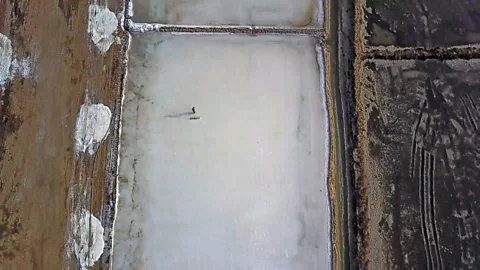 Ocean Film Company and Sreya Chettarjee
Ocean Film Company and Sreya ChettarjeeFor most of the year, one of the world’s largest salt flats is a vast sea of parched white desert – and then it completely disappears.
 Ocean Film Company and Sreya Chettarjee
Ocean Film Company and Sreya ChettarjeeLocated roughly 100km from the Arabian Sea in the western Indian state of Gujarat, a vast expanse of snow-white salt cakes a barren desert, creating a surreal series of saline mudflats that stretch north to India’s border with Pakistan. Known as the Rann of Kutch, this tortoise-shaped landmass is divided into two parts: the Great Rann, which covers 18,000 sq km, and the Little Rann, which comprises more than 5,000 sq km. Together, these blindingly white mudflats and tall grasslands form one of the world’s largest salt deserts and provide up to 75% of India’s total salt harvest.
Yet, for several months each summer, as the monsoon rains flood the Ranns, this land of parched white salt completely disappears, transforming into a shimmering inland sea that simmers under the blistering sun.
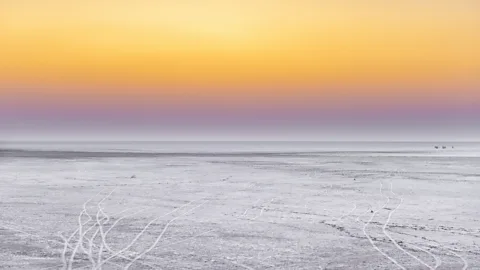 Getty Images/schita
Getty Images/schitaThe two Ranns are set between the Gulf of Kutch on India’s western border and the mouth of the Indus River in southern Pakistan. While the Great Rann (located roughly 100km north-east of the city of Bhuj) is often referred to as India’s endless “White Desert” and has little wildlife, the Little Rann (located south-east of the Great Rann to which it connects) has become something of a sanctuary for migrating birds and wildlife. Yet, these two landscapes share much in common.
Towards the end of June, monsoon rains pummel the Ranns, flooding the region until October when the water slowly begins to evaporate. As the water recedes, migratory salt farmers begin setting up rectangular plots to begin harvesting the salt crystals left behind by the evaporating water. From winter until the following June, when the rains pour down again, farmers harvest as much of the raw salt crystals as they can.
“The topography of the white desert is so flat that you start seeing the horizon as if you are looking into the sea, sans the water and waves,” said Mitul Jethi, a local tour guide.
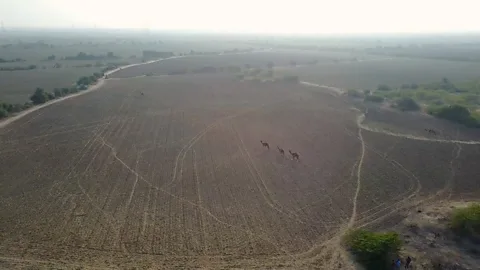 Ocean Film Company and Sreya Chettarjee
Ocean Film Company and Sreya ChettarjeeThe geological origins of the Rann of Kutch began more than 200 million years ago in the pre-Jurassic and Jurassic periods. Until several hundred years ago, the area was a navigable sea route for ships entering the Gulf of Kutch and sailing upstream into the Indus River. The Indus people, one of the world’s first large civilisations, prospered in this area from 3300BC until 1300BC.
However, a series of massive earthquakes some 200 years ago greatly altered the region’s topography. The jolts caused the landscape to rise, creating a series of depressions that filled with sea water and formed a 90km-long and 3m-high ridge that closed off this once-navigable river basin from the Arabian Sea. These events essentially trapped the salt water in the desert and created the Ranns’ unique topography.
 Ocean Film Company and Sreya Chettarjee
Ocean Film Company and Sreya Chettarjee"We found a mast of [a] ship in the desert that was isolated during one of the earthquakes and couldn't reach the main sea. It was such an amazing visual: a wooden mast in the middle of nothing!" said Dr MG Thakkar, a geologist at Gujurat’s Krantiguru Shyamji Krishna Verma Kachchh University.
 Ocean Film Company and Sreya Chettarjee
Ocean Film Company and Sreya ChettarjeeOver the past 200 years, salt farming has become a huge industry in the Ranns. Many of the migratory workers who venture to this submerged, monsoon-soaked desert in October come from the nearby Surendranagar district or are part of the Kohli and Agyariya ethnic communities. Salt harvesting in the Ranns continues nonstop until June and farmers work under harsh conditions in some of India’s hottest temperatures.
As the rains recede in October and November, workers begin the harvesting process by drilling the ground and pumping out the saline groundwater. The water is spread among a series of handmade rectangular plots, which are divided by the desired salinity of the raw salt. It may take up to two months for this briny water to evaporate, at which point the farmers begin ploughing the land 10 to 12 times a day by hand until all that remains is pure raw salt. Farmers may harvest up to 18 plots in a single season
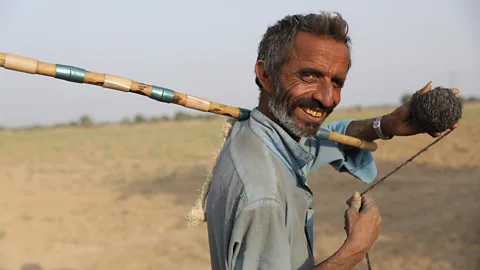 Ocean Film Company and Sreya Chettarjee
Ocean Film Company and Sreya Chettarjee"It is our fifth generation that is into salt farming. Every year for nine months, we bring our whole family to the salt farms and then again leave for our homes during the rains," said salt farmer Rasikbhai Kalubhai.
 Ocean Film Company and Sreya Chettarjee
Ocean Film Company and Sreya ChettarjeeIn addition to the Ranns' unique landscape, the desert is also home to a unique form of architecture known as bunga houses. For several centuries, many of the nomadic communities and tribes living throughout the region have survived in these cylindrical mud huts with conical roofs. While the outsides are often stylised with paintings, these engineering marvels are designed to survive the desert’s gale-force winds, the frequent earthquakes that still rock the region and the territory’s extreme temperatures – which can soar to 45C in the summer and dip close to freezing in the winter.
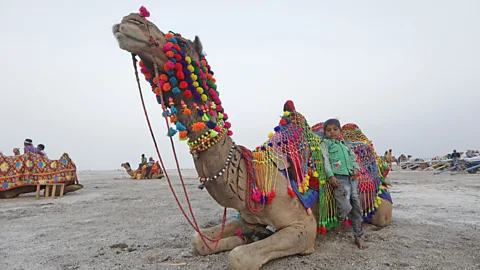 Ocean Film Company and Sreya Chettarjee
Ocean Film Company and Sreya ChettarjeeIn recent years, the Ranns have become a big tourist attraction. People from all over the world now flock to experience India’s breathtaking salt deserts. Tourists typically visit in the dry, salt-white winters, embarking on camel or Jeep safaris into this vast land of nothingness. One of the main attractions is witnessing the sunrise and sunsets in this surreal setting. Other visitors plan their trips around full moon nights to immerse themselves in the desert under the sparkling moonlit sky.
"Looking at the sunset, I felt at peace with myself,” said Jamie Bersie, a tourist visiting the region from Toronto, Canada. “This place visually looks like another world with nothing for miles and miles. It feels meditative just standing here and feeling the wind and open horizon."
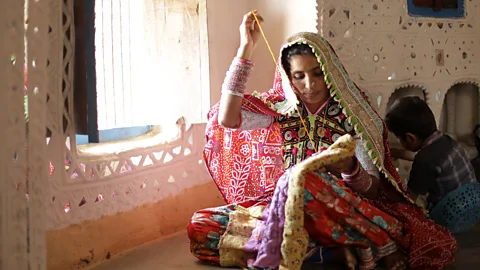 Ocean Film Company and Sreya Chettarjee
Ocean Film Company and Sreya ChettarjeeIn an effort to boost tourism, the state of Gujarat has started to fund local, small-scale household handicraft enterprises. The arts and crafts produced by the various nomadic communities living in the Kutch region are renowned throughout India. In fact, many styles of printed textiles produced in the Ranns – such as batik block printing, naturally dyed bela prints and rogan castor seed oil painting – are quickly disappearing elsewhere.
The local government is now promoting these handicrafts as part of the annual Rann Festival, a series of multi-day events featuring music, dance, crafts and local culture coinciding with the winter full moons from November until February each year.
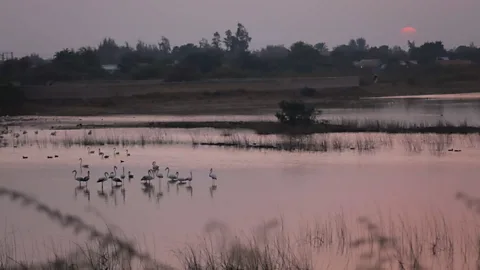 Ocean Film Company and Sreya Chettarjee
Ocean Film Company and Sreya ChettarjeeThe extreme rains, heat and flooding of the Ranns have created a unique ecosystem suitable for a staggering amount of flora and fauna. In the winter months from October to March, flocks of migrating birds make their home in the Little Rann, including eagles, storks, cranes, sand grouse, chats, warblers, and arguably the Ranns’ most famous feathered residents, flamingos.
The Little Rann is also one of the last refuges of the endangered Asiatic wild donkey. Elsewhere, are desert foxes, Indian blue bulls and chinkara (often called “Indian gazelles”).
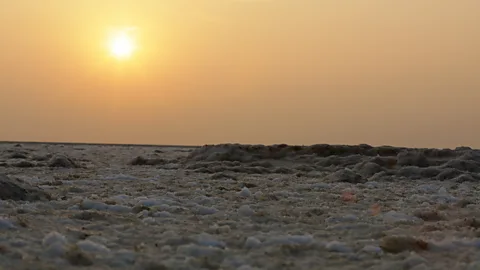 Ocean Film Company and Sreya Chettarjee
Ocean Film Company and Sreya ChettarjeeCharred by scorching heatwaves, submerged by pounding rains and blistered by long, cold winters, the Ranns are still very much a geological marvel in the making. The region regularly attracts ecologists and geologists eager to study how such an extreme and seemingly inhospitable terrain can attract so much life and yield so much salt from such a barren base.
But as sure as the rains will come in the summer and the birds will return in winter, humans continue to be drawn back to this canvas of whiteness each dry season to stare into the endless horizon and be enchanted by this parched natural wonder.
World of Wonder is a BBC Travel series exploring some of the most awe-inspiring natural phenomena and manmade marvels around the globe
